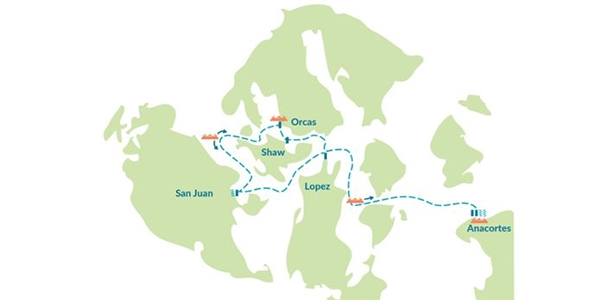By Margie Doyle
In order to help air matters attendant to the Shoreline Master Program update with county residents, this month the Friends of the San Juans joined forces with Futurewise to present forums to the county public. Last Tuesday, June 4,the topic at the Orcas Island Forum was “Sound Shoreline Science.”
The Shoreline Management Act was passed by voter initiative in 1972; resultant Shoreline Master Programs (SMPs) are local plans and regulations to protect the value and safety of public and private properties. Each Washington state city and county is required to update and adopt new SMPs every seven years. Literature from Futurewise states, “For a property owner, a SMP provides certainty over what is required for any development or redevelopment on their land.”
After an introduction by Katie Fleming of the Friends and Heather Trim of Futurewise, the forum presented research about the functions and values of nearshore environment by Jim Brennan, Marine Habitat Specialist with Washington Sea Grant; and applying economic values to the services of the nearshore environment with Lola Flores, Research analyst with EarthEconomics.org
Brennan described nearshore ecostystems as the interface of coastal landforms and marine water, including tidally influenced portions of rivers and streams. He emphasized the importance of ecological balance and long-term maintenance in nearshore areas. Among the critical functions provided by nearshore vegetation is the protection of shorelines from erosion and shading of nearshore waters necessary for the regeneration of marine creatures..
Buffers and setbacks are needed to maintain the character and function of natural systems, including wildlife and and exchange of nutrients. In King County, 79 percent of all documented wildlife species resided in nearshore ecosystems.
Coastal areas are popular to live in, due in great part to the ecosystem “services” provided by the coast environment: temperate climates, biodiversity, recreation, and historic, scientific and educational value. Fifty percent of humans live within 100 km. of a marine coast; the population density there is three times what it is further inland. However, coastal ecosystems now experience a loss worldwide of 20 percent annually. The National Research Council has concluded that legal protections of these systems is inadequate.
Brennan showed pictures of eroding coastal bluff areas that had been denuded of vegetation, and where bulkheads had been installed, preventing the natural maintenance of the bluffs. Drastic erosion, such as seen recently on Whidbey Island, was the result in each case.
Lola Flores came to the Sound Shoreline Science Forum from her work in Clallam County to speak about the economic value of nature, or “natural capital.” She made the direct link between a healthy environment and a healthy economy; citing such elements as fisheries, wildlife viewing, tourism, and a healthy water supply,. She illustrated this link by comparing New York City’s experience during Hurricane Sandy last year, and that of New Jersey at the same time. New York draws its freshwater supply from the Catskill Watershed, and maintained its water system despite the storm. New Jersey had no such watershed, and the cost was $2.6 billion to regain water services.
The economic value of a healthy ecosystem increases over time with little maintenance; on the other hand, the cost of avoidance and replacement in over-developed, unmitigated or damaged ecosystems is an economic drain.
The mid-day forum was attended by six students, six staff and about 12 adult community members.
**If you are reading theOrcasonian for free, thank your fellow islanders. If you would like to support theOrcasonian CLICK HERE to set your modestly-priced, voluntary subscription. Otherwise, no worries; we’re happy to share with you.**






